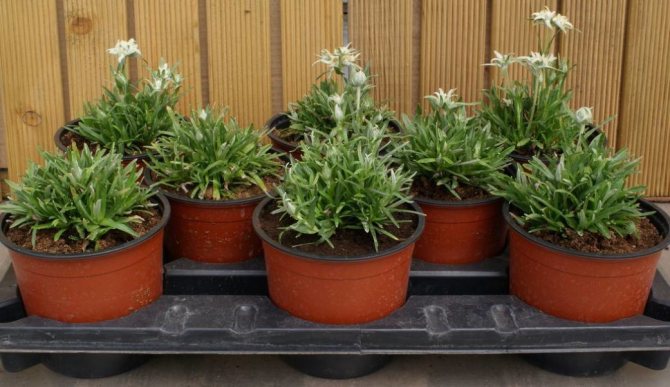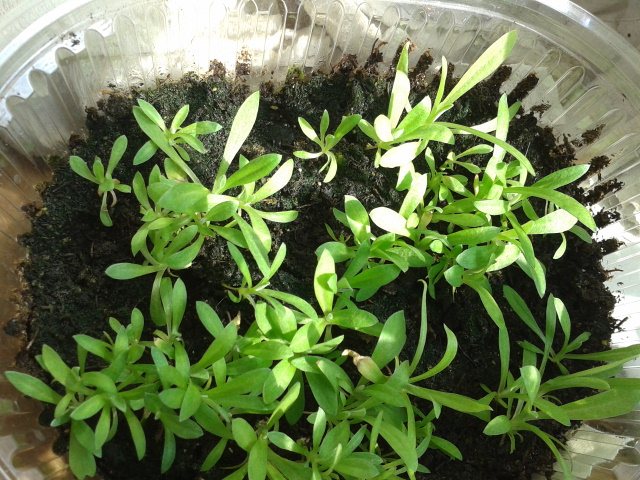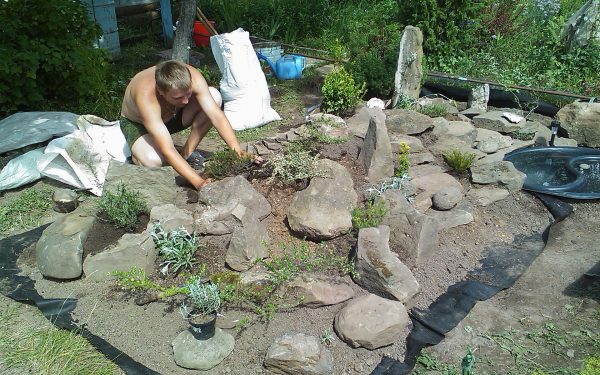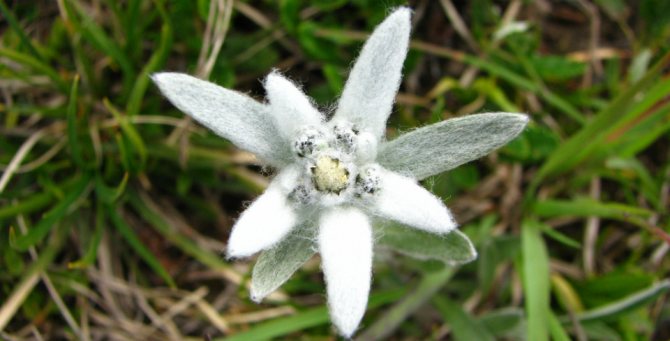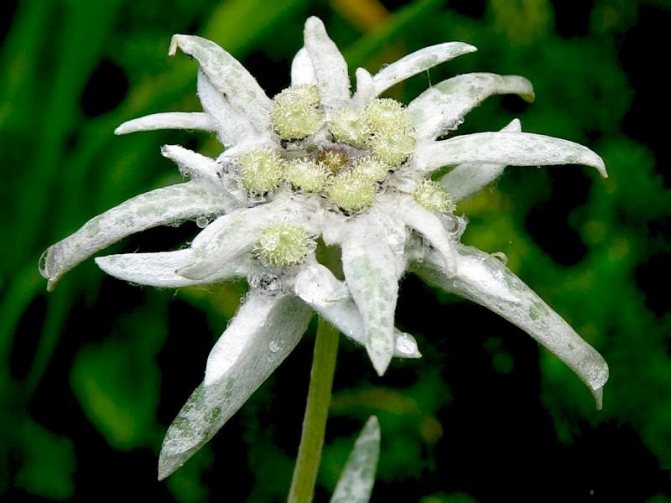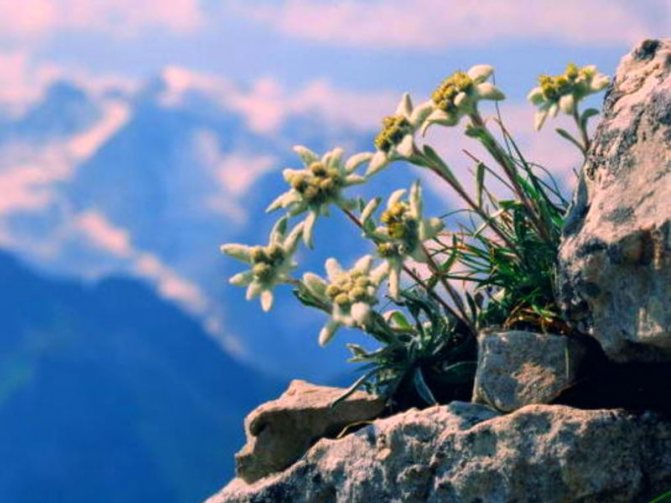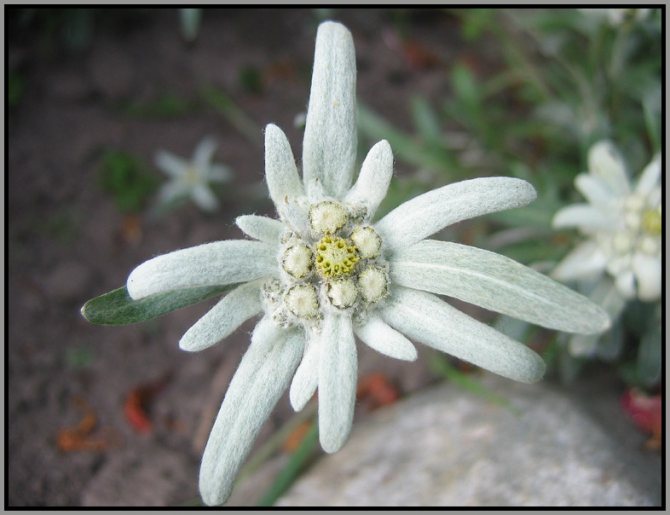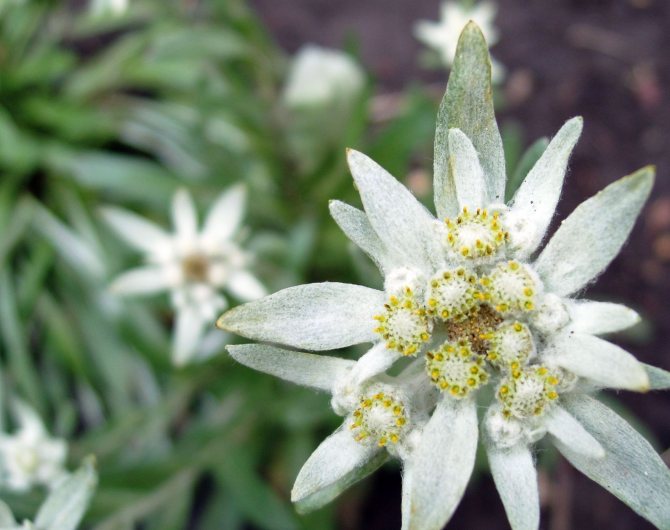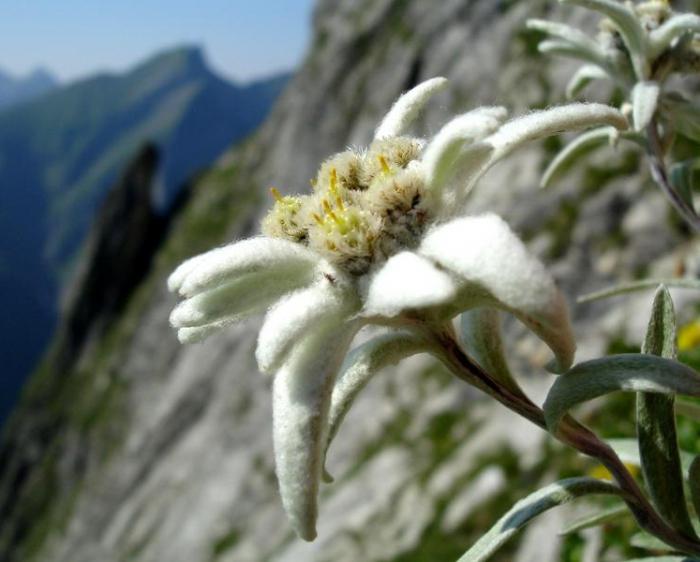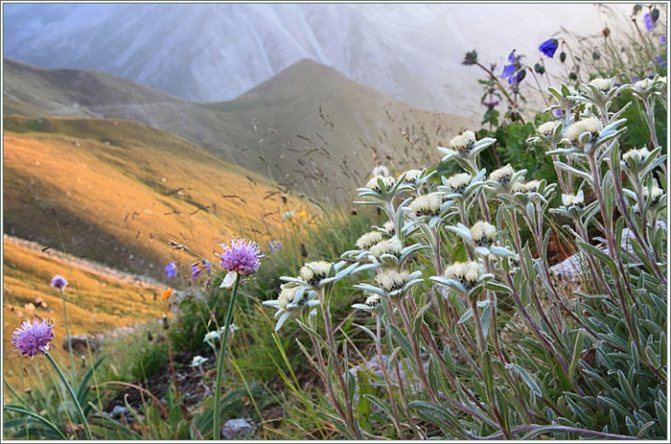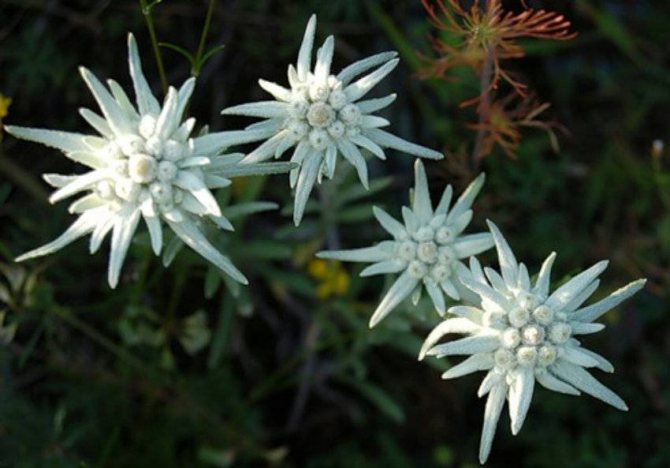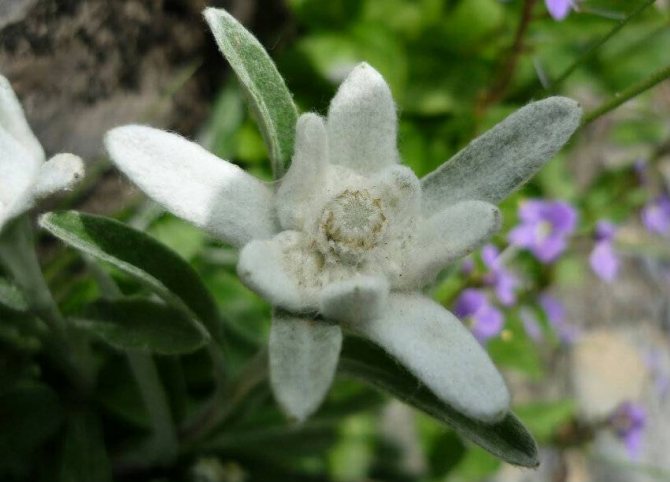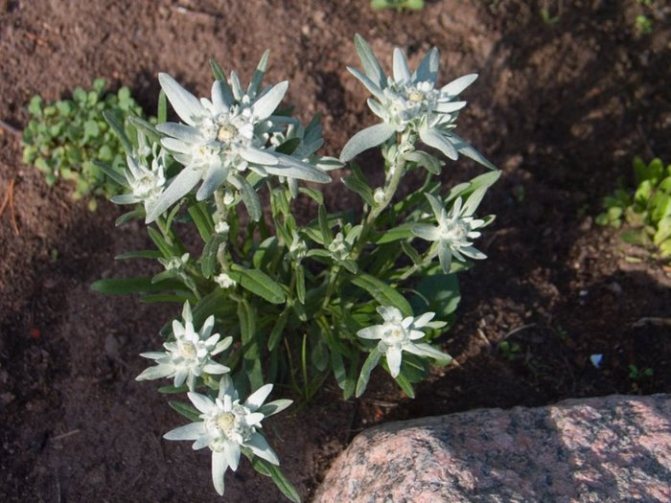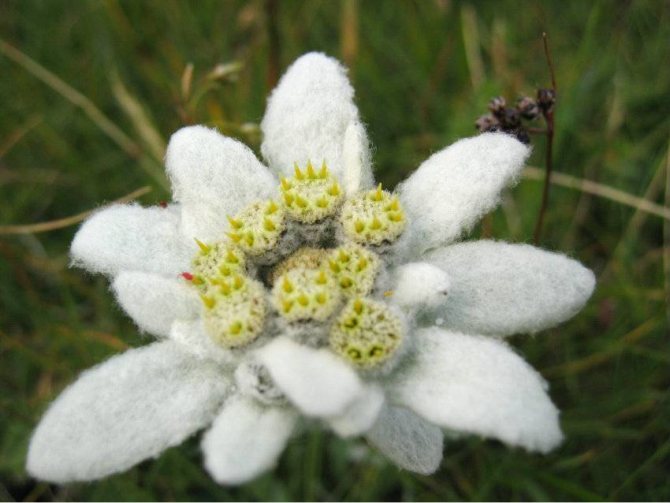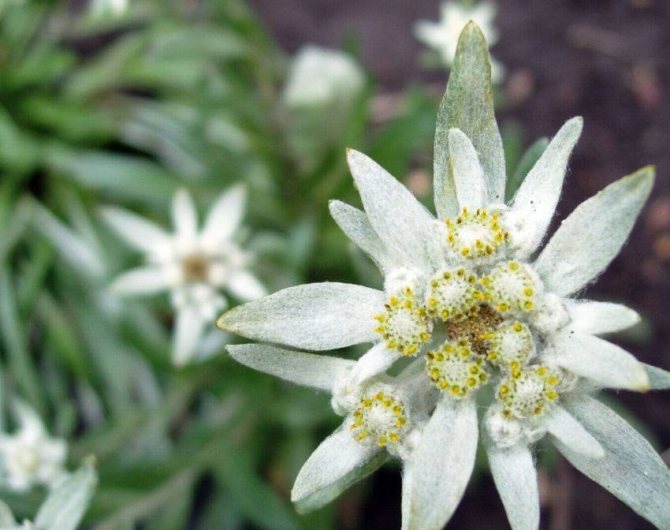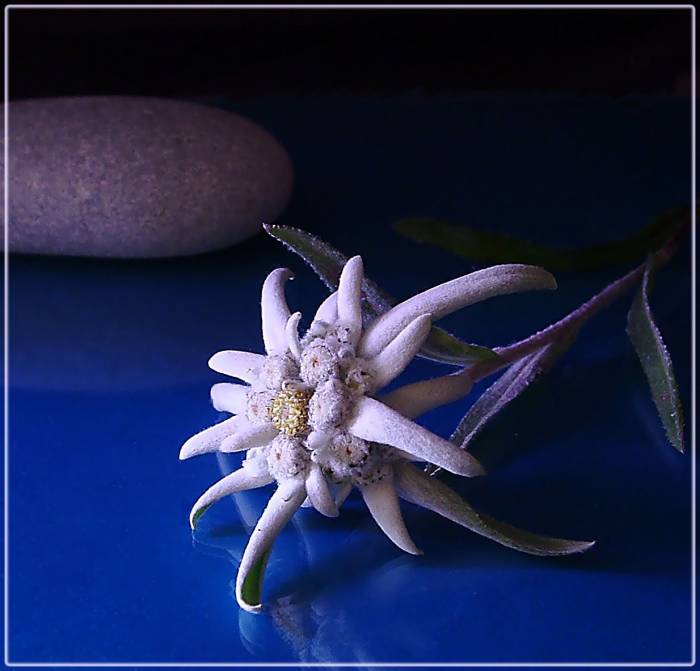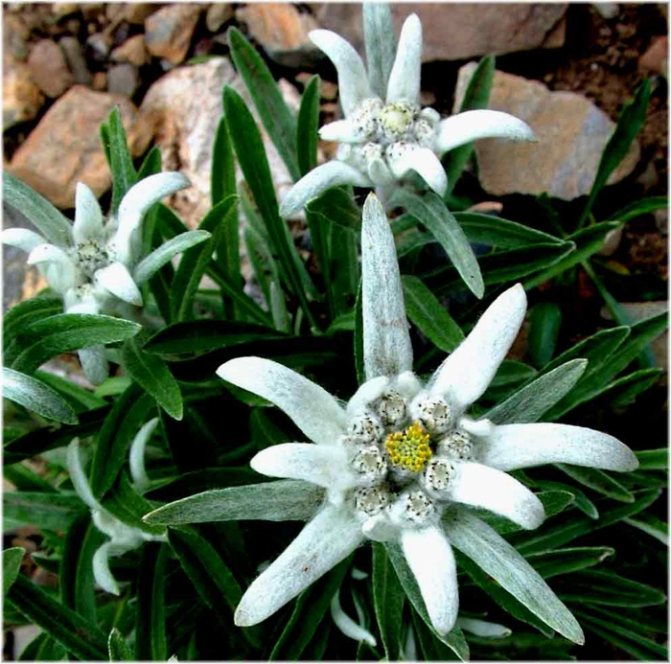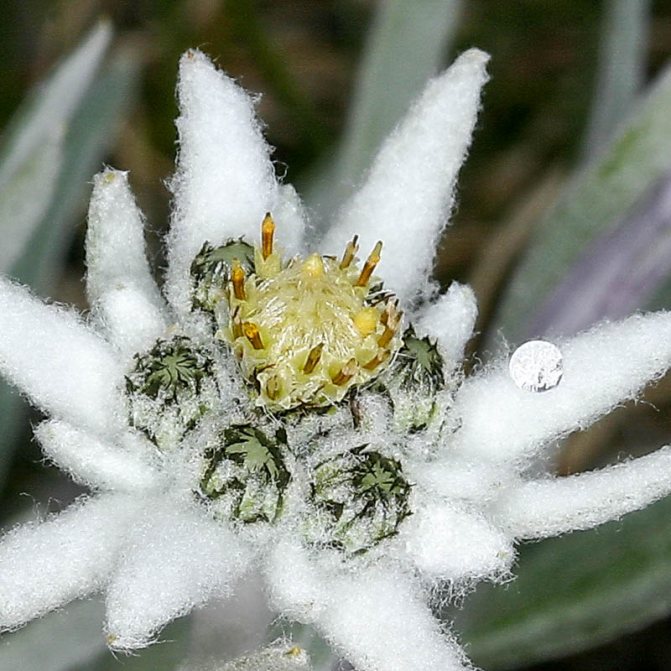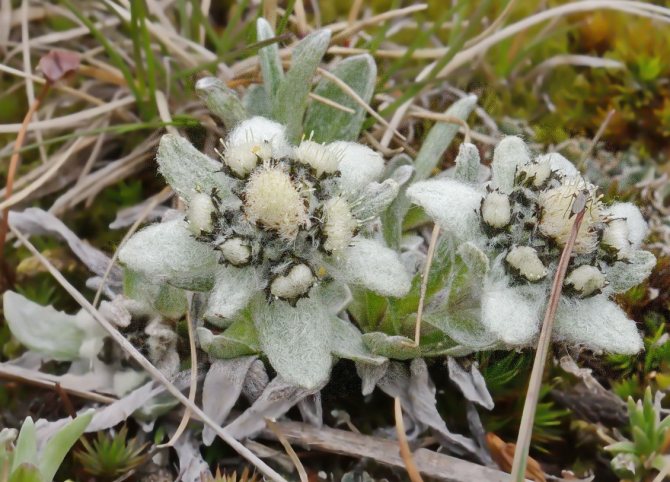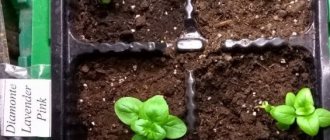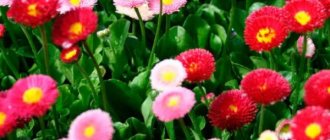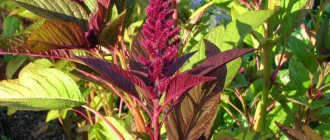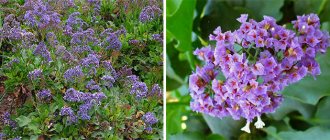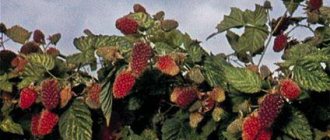I decided to make an alpine slide at my summer cottage. For a long time I selected plants that would be combined with each other. A friend suggested growing Edelweiss. It has become a real decoration, although it cannot be called a bright plant, it will simply "get lost" among the roses. But along the curbs and in the rock garden it looks just fine. Since the plant is quite rare, I had to collect all the information that I want to share today. How to plant and then care for Edelweiss and consider in more detail.
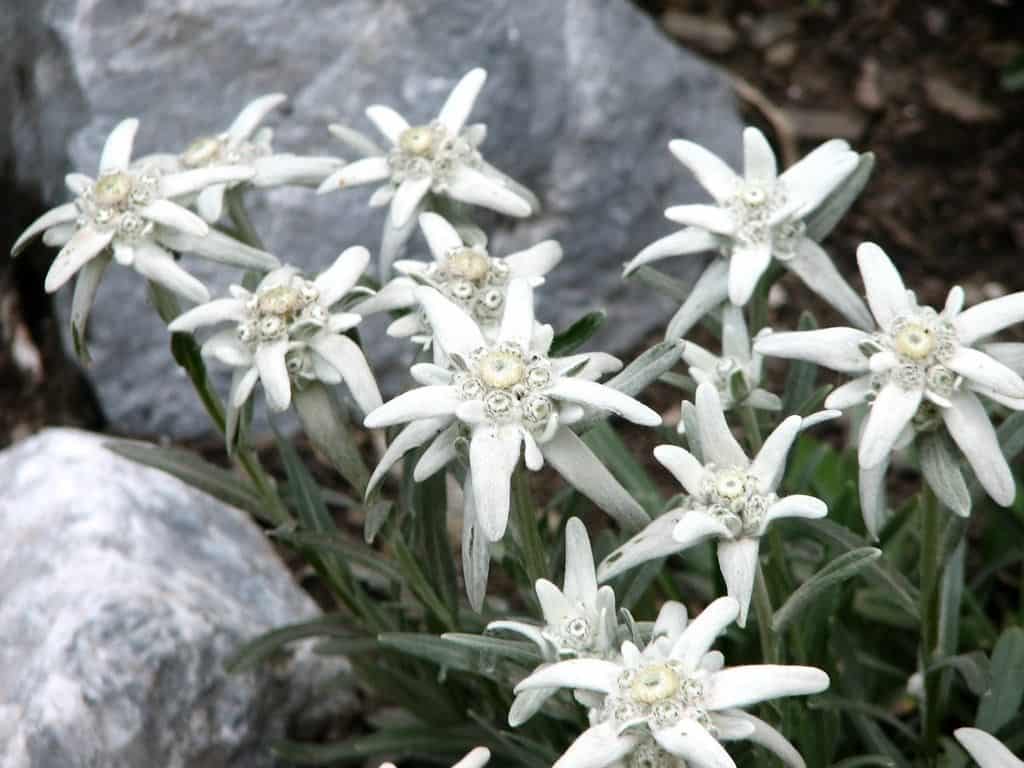
Planting and caring for the plant step by step
- Rus. name: Edelweiss, or leontopodium.
- Lat. title: Leontopódium.
- Class: dicotyledonous herbaceous plants.
- Family: Asteraceae or Compositae.
- Flowering period: May - July.
- Color: silvery white.
- Plant height: from 12 to 25 cm, depending on the species.
- Climatic conditions: drought-resistant and frost-resistant.
- Features: the name of the plant Leontopódium is explained by the fact that the inflorescences resemble the paw of a lion (leon) - "lion" and (podion) - "paw". And Edelweis is with him. еdel - "noble" and weis - "white".
- Lifespan: there are annuals and perennials.
- Distribution: high-mountainous regions of Europe, Asia.
"Red Edelweiss" is just a legend about climbers.
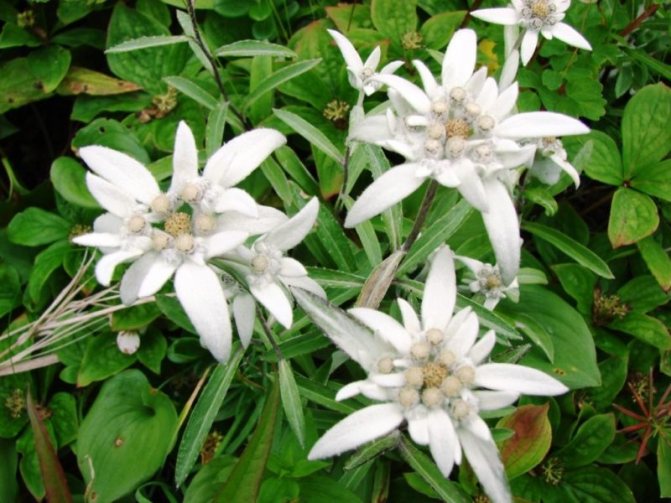

The mountain flower is considered a symbol of strong love, courage and courage.
| Propagation by cuttings Advice: the division of the root system of edelweiss must be carried out with extreme caution, since this plant is very sensitive to any manipulation of this kind. Soil: rocky, sandy with good drainage. Rooting time: May - June. How to propagate:
|
| Seed propagation Tip: growing from seed is the most efficient way to propagate edelweiss. Fruits (achenes) should be used harvested last year. Soil: A universal mixture for flowers and vegetables, or a soil mixture of sand and leafy earth 1: 2, is suitable. Seed stratification (hardening): about 1 month. Sowing period: March - April. Seedlings:
Sowing technology: practically does not differ from planting garden plants and vegetables.
|
| Planting edelweiss in open ground Note: The mountain flower is widely used by gardeners in the creation of alpine slides. Priming:
Planting period: the grown seedlings are planted in the spring, after the end of the frost. Late May - early July. Sun or shade:
Distances between holes: approx. 15 cm. Neighborhood with other plants:
|
Alpine edelweiss can be propagated by seeds, dividing the bush, cuttings. The advantage of vegetative reproduction is that its species characteristics are preserved.
Seeds
You can start sowing seeds for seedlings already at the end of February. The seeds are preliminarily kept in the refrigerator for 2-2.5 months. Then they are sorted out, dry, non-viable, disinfected in a weak solution of potassium permanganate for 15-20 minutes. Planting seeds is done as follows:
- drainage from small stones or expanded clay is poured at the bottom of the planting box;
- a substrate consisting of leafy earth and sand is poured;
- shallow grooves are made into which seeds are planted, covered with soil;
- plantings are sprayed with water from a spray bottle;
- the box is covered with glass or plastic wrap.
Seedlings will appear in about 2 weeks. Every day you need to ventilate the container and wipe condensation from the covering material. In early June, young plants are planted in a permanent place. Alpine edelweiss will bloom in 2 years.
By dividing the bush
Overgrown bushes are propagated in this way. To do this, the bush is carefully dug out, trying to injure the roots as little as possible. With a sharp knife, edelweiss is divided into 2-3 parts. Each of the divisions should have several growth points.
The procedure is carried out in spring or autumn. Bushes are planted at a distance of 15-20 centimeters from each other. The separated plants bloom next year.
By cuttings
Propagated by cuttings alpine edelweiss in June. To do this, use the tops of last year's shoots. The substrate for seedlings is selected from sand, leafy earth with the addition of lime.
Cuttings are planted as follows:
- cut off parts of shoots are powdered in a preparation that stimulates root formation;
- at a distance of 10-15 centimeters, cuttings are planted in damp ground;
- cover the plantings with jars to retain moisture in them.
Seedlings are watered as needed. When they start to grow, the banks are removed. Blooming will come next season.
Important! Vegetative reproduction allows you to preserve the external features of the species.
The most reliable way to plant edelweiss is by seedlings. The timing of sowing seeds for seedlings is traditional - February - March. The technology of planting and growing edelweiss seedlings practically does not differ from growing seedlings of annual garden flowers and vegetables. To enhance germination, edelweiss seeds can be pre-prepared.
That is, subject them to stratification for a month. It will be most convenient to mix edelweiss seeds with coarse sand or (even better) with perlite, and spread evenly over the entire surface of the planting soil mixture without embedding them in the ground. As a soil, the usual universal mixture is suitable. Then everything is as with ordinary seedlings, cover the container with glass or film, moisten, ventilate, etc.
At the same time, you can sow edelweiss seeds directly into the open ground, if you prefer this planting method.
Over time, when the flowers grow well, the bushes can be separated.But keep in mind - edelweiss is a very sensitive flower, and it must be divided with the utmost care and accuracy.
Alpine edelweiss is grown at home by cuttings, cuttings or seeds. In late spring - early summer, cuttings are cut from the tops of the shoots, for better rooting, they are dipped in a root former and planted in open soil. For the next season, the plant is capable of flowering. If there is already an adult edelweiss bush on the site, you can dilute it by dividing it. The roots of the flower are quite strong and very easily adapt to changing conditions.
The procedure should be carried out at the beginning of autumn or somewhere in August. The new bush will bloom next year. The plant is dug up and divided into 2 or more parts with a sharp knife or pruner, with the obligatory presence of buds on each. Then they are planted in prepared holes in their places. Alpine edelweiss propagates well with the help of seeds in March, when using this method:
- last year's seeds are mixed with damp earth and kept on the bottom shelf of the refrigerator for about 20 days;
- then placed in containers with a mixture of leaf earth and sand, taken in a ratio of 2: 1;
- the container is covered with a film or glass and left in a shaded place at a temperature of 15 ° C;
- After about 20-25 days, shoots are formed, then the shelter is removed, and the container is rearranged to the light.
Seedlings are characterized by very lingering growth, so be patient. When they reach 2 cm in height, they are dived for growing. After the threat of frost has passed, they can be planted in the garden, keeping a distance of 15 cm between the bushes. Vegetative propagation methods make it possible to preserve all species characteristics, but with a seed plant, it may differ in appearance from its relatives in nature.
Gallery: edelweiss flower (25 photos)
The Legend of Edelweiss
There are many legends about this flower. One of them says about a proud beauty who decided to marry a daredevil who plucked an edelweiss growing high in the mountains. Many young people fell off the rocks and died.
Finally, a young man appeared, to whom the mountains conquered, and he tore off the edelweiss. The princess was delighted, but by this time her beauty had faded, and the young man presented the flower to a completely different girl. Following the legend, many guys strive to present this flower to their future wives.
Note! In many countries, it is forbidden to pick edelweiss, therefore, an ornament in the form of this flower is presented as a gift.
Edelweiss flower: its types, cultivation, photo of the plant
Edelweiss (Leontopodium) or leontopodium is a genus of herbaceous plant of the Aster family.
Edelweiss is a word of German origin, meaning "noble white". The flower is shrouded in numerous legends about romantic love, secrets, it is considered a symbol of loyalty and devotion.
This small, beautiful flower is shrouded in many secrets. Even in ancient times, he was considered a symbol of loyalty, love and courage... Men, risking their lives, procured this flower for their beloved high in the mountains.
In nature, the plant grows among rocks, rock fragments. More often found in the Far East, as well as in the mountainous regions of the Himalayas, Carpathians, Tibet. Loves the burning rays of the sun.
Growing and caring for edelweiss
Soil type: Edelweiss flower prefers well-drained soil and the pH should be between 6.5 and 7.5. The soil should be sandy.
Watering: Edelweiss, which is easy to grow, requires regular watering.
Reproduction: carried out by planting seeds. If you decide to reproduce edelweiss from seeds in the garden, then the seeds should be scattered directly on the surface of the soil, and the best period for this is the beginning of spring, until the last frost. The distance between plants should be 8 to 30 cm.If you plan to propagate edelweiss at home, the first shoots will appear in 1-8 weeks.
Additionally: edelweiss prefers to grow in snow, so you need to pay special attention to it if you live in a region where there is no snow. In such a situation, it is recommended to use mulching in the winter. This will create an imitation of snow cover. Mulching should be removed in early spring. If you live in a country where it snows, then leave the flower in the winter, but protect it from heavy rain.
Providing the alpine edelweiss with the necessary conditions, the gardener will be able to admire this plant for a long time.
The peculiarity of growing edelweiss is that it does not need a fertile soil, since this loses the decorative effect of the flower. On poor, but at the same time light and loose soils, on the contrary, it feels great. Crushed stone, coarse sand, and lime are added to the substrate.
In nature, culture grows high in the mountains, where it is brightly illuminated by the sun. In the garden, he needs to be provided with the same bright area, preferably located on a hill. In lowlands and depressions, he has no place, since he does not tolerate stagnant moisture.
What to plant next
Alpine edelweiss is a modest flower, so it is not planted next to spectacular plants. Against their background, he will be lost. It is combined with the same undersized plants as it is: alpine aster, young, heuchera, blackhead, viola, stonecrop, meadow sage.
Many amateur gardeners believe that edelweiss cannot be grown at home. This opinion is fundamentally wrong. In order to make sure that the edelweiss flower can be grown at home, just look at the photos of the design of the alpine slides on the sites dedicated to landscape design.
This flower gets along well on alpine hills among a large number of other plants. It should be remembered that the plant requires a lot of sunlight. This factor must be taken into account when choosing a place for planting a plant.
The main requirement for growing this plant is the absence of even the slightest stagnation of moisture.
The plant should be planted in poor calcareous soil, to which some sand should be added.
When caring for a plant, those peduncles on which flowering has stopped must be removed, since they lose their decorative qualities.
The Edelweiss flower, judging by the photos located on the sites dedicated to landscape design, should be planted on alpine hills or in rocky gardens. This flower goes well with blue and pink flowers. It should be remembered that when decorating a landscape, this flower can get lost among bright and luxurious flowers, since it is more modest in design compared to others.
After planting a plant in the ground, it requires careful care. When planting a plant, it should be borne in mind that the feeding area for one individual should be at least 20x20 cm.
The planted plant requires feeding in the autumn and spring periods of development. Top dressing should be carried out using complex mineral fertilizers.
Although under natural conditions edelweiss most often grows in the sunniest places, in home growing it is best to plant it in light partial shade. The main requirement for the site is that it should not be in the lowlands where moisture accumulates! The soil on the site should be poor, with a minimum content of nutrients.
At the same time, the land must be very good at allowing moisture to pass through, preventing stagnation of water. It is highly desirable to create conditions for edelweiss as close as possible to natural ones. Add coarse sand and small stones to the ground. It also drains the soil.
Edelweiss look equally good both in group plantings and singly. But if you want to achieve naturalness, then do not plant them in large groups. Edelweiss is not a cornflower or a chamomile, it does not grow in glades! This flower combines very well with other low-growing garden flowers, especially with those recommended for the organization of alpine slides. Exceptions are creepers (periwinkle, for example). Such plants are able to suppress the growth and development of edelweiss, up to their death.
Edelweiss does not need special care. Watering is moderate, and even then, if the summer is hot and dry. Natural watering is usually sufficient. Edelweiss does not need loosening of the soil, moreover, they are harmful to it. It is imperative to break through the weeds.
Edelweiss tolerates cold quite well, but before the onset of cold weather it is still advisable to slightly cover it with mulch (peat, fallen leaves, sawdust, etc.).
Every two to three years, edelweiss must be transplanted to another place. It is also possible within a flower garden or an alpine slide. If it grows in one place for a long time, it will quickly grow and lose its decorative effect.
Have you noticed a mistake in the text?
Select it with the mouse and press Ctrl Enter
What conditions does edelweiss need for successful growth?
For the successful growth of edelweiss, certain conditions must be observed. All these factors, of course, depend on the climatic zone in which it will be grown.
Interesting fact! Edelweiss is a flower of love. Having presented it to his beloved, the young man confessed his eternal love for the girl.
Does edelweiss need the sun, how to choose lighting for a flower
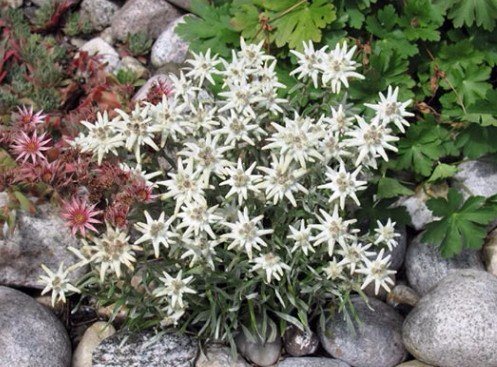

For the successful growth of edelweiss, it is necessary to choose a well-lit place. Areas on which there is no stagnation of water on a hill are recommended. But at the same time, edelweiss can easily grow in partial shade. It would be nice to choose an area for him in which the sun will illuminate the plant until lunchtime, and in the afternoon it will make a slight partial shade.
What should be the soil for edelweiss
For planting edelweiss, light, loose sandy soil is suitable, which can easily pass water. The soil should be well dried, with an admixture of gravel or coarse sand. Also, lime must be added to the ground.
Important! Do not mix the soil for planting edelweiss with manure.
Characteristic features of the plant
Edelweiss is a herbaceous plant, reaching a height of 15-25 centimeters. It has narrow leaves, which, thanks to the fleecy pubescence, are capable of retaining moisture for a long time. The inflorescence is a basket of white or yellow flowers. It is surrounded by star-spread leaves.
Thanks to the creeping rhizome, edelweiss is able to grow independently. Due to this quality, the flower is used as a ground cover plant. But, in order to grow it on his site, the gardener must provide the plant with conditions close to natural.
Description


The mountain edelweiss flower is modest and delicate, charming with its simplicity and shape. The inflorescences-baskets are colored yellow, their uncomplicated appearance is beautifully set off by pointed leaves. Having an unusual silvery color, they found the name of the Alpine stars. Their top is darker than the bottom side, which is densely covered with white felt. The silvery and white range of colors is appreciated by florists for its originality. They are happy to use fresh and dried edelweiss flowers in bouquets.
Cut alpine stars retain their shape and color when dried. They can be safely used in herbariums and ikebans.


On a flower bed, flowers get along with neighbors, they do not clog them with their exuberant growth. However, they look best against the background of stones. They are recommended to be combined with rock and conifers.
General characteristics of an alpine flower
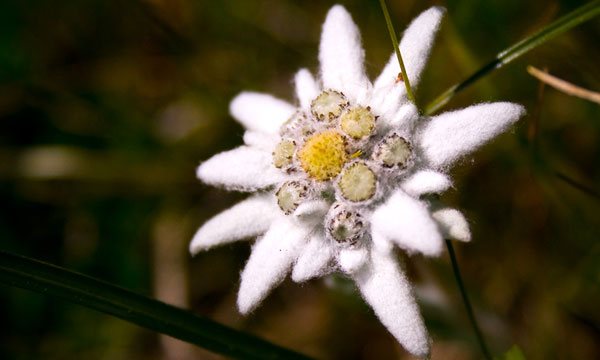

Edelweiss or leontopodium (which means "lion's foot" in translation) can grow on poor rocky soils and in hard-to-reach places between rocks and on high cornices. The plant can have different parameters, but most often they reach 20-25 cm, both in height and in width. The stems of the flower have a slightly curved shape, they can sometimes branch out in the upper part, forming squat bushes.
The baskets are painted in gray-yellow tones, the rest of the petals are snow-white. The inflorescences, like the whole plant, are densely covered with soft villi, which gives it a silvery tint. Such a covering in natural conditions serves as a kind of protection from the cold climatic conditions of the mountains. Flowering occurs in late spring or summer, after which the seeds ripen with tiny flying seeds. The roots of the plant are creeping, which is why it is able to grow on its own.
Edelweiss are perennial or annual herbaceous plants that have a height of 12 to 25 cm. The plant has leaves with a narrow, elongated leaf blade. The leaf blade is covered with villi from below, which protect against excessive moisture loss. The upper surface of the leaf blade has a silvery color.
The inflorescence of the plant is finite, complex, consists of baskets twisted into dense formations. The baskets include white flowers or flowers with a yellowish tint.
Baskets in the inflorescence are surrounded by linear leaves that have a star-spread shape.
To date, plant taxonomy includes more than 60 species in the genus Edelweiss. Each type of edelweiss flower has external distinctive features that can be easily detected by comparing photos of flowers of different types.
The most common types of this plant are the following:
- Leontopodium alpinum;
- Leontopodium fauriei;
- alpine edelweiss;
- Leontopodium brachyactis;
- edelweiss Fedchenko;
- Leontopodium japonicum;
- Leontopodium leontopodioides;
- Leontopodium ochroleucum;
- Siberian edelweiss;
- edelweiss Palibina.
The Palibin edelweiss flower in the photo is very similar to the alpine species. This type of plant grows in the mountainous and steppe regions of the Siberian part of Eurasia, in the Mongolian steppes, on the territory of Manchuria and the Korean Peninsula. The plant, in the process of its growth, forms bushes that are larger in size than those formed by the alpine variety of the plant, but the flowers of this plant are smaller than those of the alpine edelweiss.
Flowering occurs from June to September. Plant development takes place on dry, poor and unfertilized soils. When a plant grows on humus-rich soils, foliage develops rapidly with a minimum number of flowers formed.
Reproduction of a plant, as a rule, is carried out in a vegetative way, by dividing the rhizome. In addition, the seed type of reproduction is possible.
After the flowering period, the plant develops seeds. Flower seeds are small in size and have flywheels.
In the late autumn period, the mother plant dies off, and in its place are annual rosettes that overwinter. For the next growing season, full-fledged plants develop from these outlets, which begin to bloom.
It is a slow growing plant that blooms luxuriantly in the high alpine mountains. This type of flower is a herbaceous perennial plant with beautiful foliage and beige-white flowers. In appearance, they resemble daisies. The homeland of this variety is southern and central Europe. It should be noted that this plant is quite spectacular, and legends and songs are even composed about it. The flower is best suited for growing in stone gardens in cool and cold climates. Belongs to the Asteraceae family.
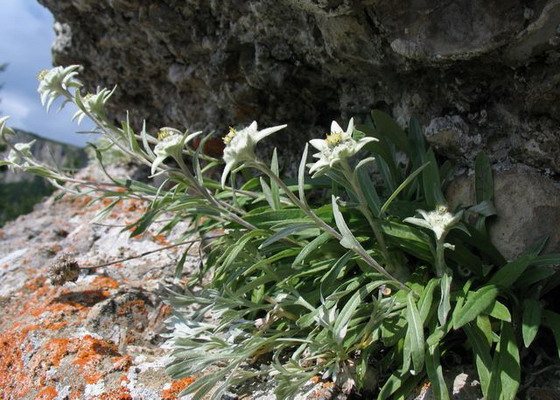

Tall edelweiss flowers in the photo.
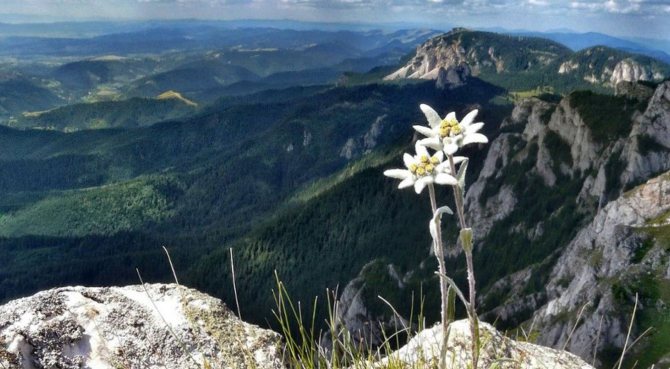

Some specimens of this species grow from 15 to 30 cm in height, and in width they grow by 15-22 cm. As they grow, edelweiss gradually expand, and they grow just as well from underground roots as from seeds. The bracts, as mentioned above, have a white tint, and they reach about 10 cm in width, while the flower itself has a yellow tint, which is skirted by the bracts. The flowers have a soft, pubescent surface that appears among the silvery-green foliage.
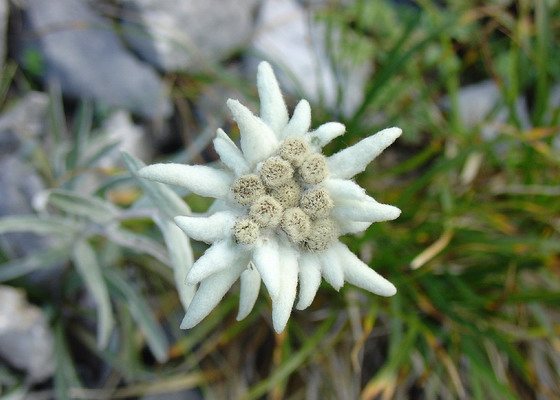

Photo of edelweiss on natural stones.
This type of edelweiss grows well in stony, sandy soil with good drainage, which explains its popularity in stone gardens. In addition, they look great in curbs or when planted in mass to cover the soil in the garden. The plant begins to bloom in late summer, and flowering continues until early autumn.
Like all alpine flowers, edelweiss can grow well in poor soils, cold temperatures, and be resistant to winds as well as harsh sunlight. But, despite this, plants grow rather slowly under not the most suitable conditions. Due to the fact that edelweiss are often extracted from their natural habitat, their numbers are gradually decreasing.
Common types of edelweiss
The following types of edelweiss are popular in horticulture:
| Alpine edelweiss Habitat: the natural environment for the plant is subalpine and alpine highlands. In the lower zones, mountain edelweiss looks less decorative, as it loses its snow-white felt padding. Lat. name: Leontopodium alpinum. Appearance:
Plant height: in diameter 20 - 25 cm. Color: silvery white. Flower size: about 10 cm in diameter. Features: the plants are completely covered with small, dense villi that protect them from frost down to -30C. Life Expectancy: perennial |
| Edelweiss dwarf Lat. name: Leontopodium Slavica. Appearance:
Plant height: 5 - 10 cm. Color: the leaves are dark green, the flower is silvery-white with yellow baskets. Features: in this type of edelweiss, the bracts do not form a star-shaped form. Life Expectancy: perennial |
| Edelweiss is pale yellow. Lat. name: Leontopodium ochroleucum Beauv. Appearance:
Plant height: 10 - 30 cm. Color: pale yellow. Flower diameter: 5 cm. Features: this species is able to withstand temperatures down to -34C. Life Expectancy: perennial |
The use of edelweiss in human practical life
The use of plant components is widespread in cosmetology.
An extract is obtained by carrying out alcohol-glycerol extraction using aerial parts of the plant.The extract is orange or dark brown in color. The product is practically odorless. Soluble in water and alcohol.
The extract from the aerial parts of the plant has a whole range of useful properties, the main ones of which are the following:
- antioxidant;
- regenerating;
- prevention of skin aging;
- antifungal and antiseptic.
The extract obtained from plant raw materials is used in the production of a variety of cosmetics:
- skin care creams;
- serums used to prevent aging of the skin of the face and body;
- creams that protect the skin of the body from the harmful effects of various environmental factors.
In some cases, cosmetologists do not recommend the use of cosmetics based on edelweiss extract.
Edelweiss is ideal for landing on alpine slides, rockeries or stone gardens. Due to its squat shape, the plant is often planted in the foreground of group plantings. For a flower in the role of neighbors, ground cover crops such as sedum, alissum or tenacious fit harmoniously. This flower looks beautiful against the background of low bushes.
Due to its discreet appearance, edelweiss can be lost among other flowering crops, but planted in the form of single plantings on the lawn will serve as its real decoration. Alpine edelweiss inflorescences can retain their shape for a long time without changing color, therefore they are very often used as components of dry bouquets.
For information on how to properly care for alpine edelweiss, see the next video.
Edelweiss is planted in rocky gardens, alpine hills, flower beds, located in the sun. It can frame the lower part of the trunks of the hydrangea tree, Syrian rose, cypress, and other low shrubs. The flower will look beautiful against the background of the lawn, as well as next to herbaceous plants of a contrasting texture.
Alpine edelweiss flower - a plant of good luck and love
Many legends are associated with the name of this wonderful flower. It is believed that if a young man was able to get edelweiss for his beloved, then his feeling is really strong. And this is no accident.
Edelweiss in the wild grow only on the steep slopes of the alpine mountains, on rocky slopes that rise about 1.8 kilometers above sea level. Edelweiss flowers bloom mainly in June and July. Against the background of poor mountain vegetation, this flower looks especially delightful.
Edelweiss is a flower that belongs to the dicotyledonous genus and the Aster family. This flower is common in the highlands of the Eurasian continent. The scientific name for edelweiss is leontopodium. The plant received this name for its resemblance to the paw of a lion.
You can meet a flower not only on the slopes of the Alps, but also in the Tien Shan, Pyrenees, Carpathians, although the plant is quite rare in this area. In Switzerland, this flower has recently become a great rarity, so the government has imposed a ban on the collection of edelweiss.
Edelweiss flowers are attractive not only for their extraordinary beauty, but also for their beneficial properties. According to research by scientists the plant is rich in antioxidants, which are used in cosmetology to preserve youthful skin and help protect the body from free radicals.
Products with edelweiss extract soothe the skin, so they are often used to create facial cosmetics. That is why the alpine flower today grown specifically for use in the cosmetic industry.
Cosmetic and medicinal products prepared with the use of edelweiss have an effect on fungi and bacteria, providing an antiseptic effect on the body.In addition, such drugs are able to reduce inflammation and have a positive effect in protecting against the formation of malignant tumors.
But now you can grow this wonderful flower in your garden. It is enough to create suitable conditions for this. His need rocky, sandy soil with drainage... This flower gets along well in mass plantings. Hot and humid climates can be an exception to cultivation.
Edelweiss - cultivation
By its nature, the plant is completely unpretentious, but in order for it to please with lush flowering and a healthy look, it just needs to create conditions close to natural. Alpine edelweiss, when cultivated, as in the wild, prefers to grow in areas with sufficient lighting. The flower is characterized by drought resistance, besides, it is very sensitive to waterlogging of the soil and stagnation of water.
Heavy soil or too fertilized with organic matter, together with high humidity, will lead to the loss of the decorative effect of the edelweiss, including its pubescence, as well as the formation of too elongated shoots. When planting a plant, it is worth considering its appearance, because in the vicinity of high crops it will not look the best.
Alpine edelweiss: growing in the garden
The villi that cover the entire plant protect it not only from moisture evaporation, but also protect it from frost. In winter, you can leave it without shelter, even with a small amount of snow.
The height of individual specimens can reach 30 centimeters, and the width of the bush is about 22 centimeters. These data are important to consider when planting young plants in the garden.
Edelweiss bloom in garden conditions occurs in June-August. Flowering shoots should be removed after flowering.because they lose their decorative effect. This is especially true during a rainy summer.
The soil for it is made up of coarse sand and small stones. This will create natural conditions for the plant to grow. In lowlands and hollows, a flower should not be planted: it does not tolerate stagnant water. Mineral and organic fertilizers are harmful to him. Frequent root loosening of the soil is also not required. It is better to choose a semi-shaded place for landing.
How to propagate a plant
For reproduction of alpine edelweiss, they are most often used cuttings or seeds... Small tops of the shoots are taken as cuttings, which can take root in May-June. Once rooted, the plants are ready to bloom the next year.
If you want to propagate a plant already growing in the garden, then it is better to prefer the option with vegetative propagation of the bushby dividing it. Edelweiss has an unusually strong root system and easy adaptability to new conditions. The division of the bush is usually done in early autumn or mid-spring. With such a transplant, edelweiss will begin to bloom, as with other methods for the next year.
But you can propagate an alpine flower by seeds. They do it as follows:
- Take seeds from last year.
- Seeds are sown in boxes with a nutrient mixture (take sand and leafy soil 1: 2) in the month of March.
- For hardening, three weeks before planting, the seeds are mixed with moistened earth and placed in the refrigerator.
- After sowing the seeds, the box is covered with foil or glass to retain moisture and removed to a shaded place.
- The air temperature for seedlings is maintained within + 15 degrees.
- The first shoots can be seen three weeks after planting the seeds.
- After sprouting, you can remove the film and put the box in a lighted place.
The growth of seedlings is rather slow. When the seedlings reach a growth of two centimeters, they are transferred to growing in separate pots. After spring frosts, alpine flowers are transferred to the garden to a permanent place of growth. Plants should be planted 15 centimeters apart.
Alpine edelweiss care rules
The plant will delight its owners with its extraordinary beauty in gratitude for patience and proper care. It's pretty unpretentious in the wild, requires special conditions for growing in the garden... When growing a plant in the country, you should:
- Plant it in places similar in terms of conditions to natural growth.
- Select neutral or calcareous, well-drained soils for planting.
- Monitor the amount of moisture: plants do not tolerate lack and excess of water.
- In winter, with a lack of snow mulch the soilso that it does not freeze, and remove the mulch at the beginning of spring.
- Rejuvenate the plant every three years.
- Do not feed with fertilizers (in natural conditions, it is accustomed to scarce mountain soils).
- Pwhen aphids are affected treat the bush with a special solution from the pest.
- To plant a plant in rockeries only with plants similar in terms of growth.
The plant tolerates spring frosts remarkably. When growing in one place, this flower is rejuvenated once every three years. The earth near the flower follows weed.
Alpine edelweiss can be an excellent option for planting on an alpine slide. It can be planted in the foreground in group plantings.
When planting an alpine flower in the garden, it is important to pair it with low crops. Excellent combination with edelweiss have gypsophila, alissum, sedum, tenacious and other soil cover plants.
Due to the ability of the inflorescences to retain their shape and color for a long time, they are used to compose dry bouquets. To this end, the peduncles are cut before the flowers open and dried in a suspended state with inflorescences down in a well-ventilated room.
Due to the fact that different types of plants in the wild can grow on different continents, it is necessary to establish the type of plant and the conditions for its natural growth in order to choose the right conditions for planting in the garden. Alpine is considered one of the most common types of edelweiss, but in the wild there is also a dwarf flower that grows in China and the Himalayas. The plant is also found in the region of the Kuril Islands.
In Korea, Siberia and Mongolia, you can find Pilibin's edelweiss. It should be planted in a specific location where the plant will be protected from overheating. The dwarf relative of edelweiss is very picky about the soil: it must contain a small amount of humus and must be constantly moistened during the period of flower growth.
How to properly transplant an adult plant
Due to its natural growth in mountainous areas, the flower has formed a rather long root system. When transplanting, it is required to dig deep enough holes and straighten the roots when transplanting.
When planting in a hole, sprinkle the roots with dry earth and water the plant with a little water. A successful transplant can be traced by the appearance of lateral shoots. The transplant can be called successful with active bushiness of the flower and lush flowering the next year after transplantation.
Botanical description of the plant and its variety
Alpine
This is the most common type of edelweiss. Its height in gardeners' plots varies from 10 to 20 centimeters. Mountain edelweiss inflorescences consist of scutes collected in baskets. The leaves around them seem as if they are painted white due to the thick tomentose pubescence. To preserve the characteristics of the species, it must be propagated vegetatively.
Bicolor
Bushes of two-colored edelweiss consist of erect shoots. They reach a height of 35 centimeters. White and yellow flowers, framed by leaf arrows of various lengths, bloom in July.
Kuril
This is a stunted species of edelweiss. Its length barely reaches 20 centimeters. Basal leaves are oblong, about 7 centimeters long. Stem leaf plates are smaller, felt, gray in color.The bracts, forming a star, are covered with white or yellow felt. Yellow funnel-shaped flowers bloom in late July - early August.
Plant varieties
There are about 40 plant species, but only the following are widely used in floriculture:
- Alpine edelweiss. This is the most common variety. It has terry apical leaves that form a multi-rayed star. The stem reaches 20 centimeters in height. The plant blooms in the summer months.
- Edelweiss is edelweiss. It has stems up to 35 cm high, the leaves are sharp, linear, of a grayish-tomentose color, almost glabrous from above.
- Siberian edelweiss. This is a species close to alpine edelweiss.
- Edelweiss is pale yellow. Has single stems, often balding. Bracts are lanceolate and oblong with curled edges, yellowish-greenish in color.
- Kuril edelweiss. Squat flower, straight stems, reaching 20 cm in height. As you can see in the photo, the leaves forming the "star" are approximately equal in length, whitish-tomentose-pubescent on both sides, narrow-lanceolate.
In nature, edelweiss do not form large clusters. They are found most often:
- on limestone rocky slopes;
- in cracks and crevices of rocks;
- in hard-to-reach places they rise to the line of eternal snows.
Care rules
Alpine edelweiss is distinguished by its unpretentiousness to growing conditions in nature, it is the same during cultivation. Moistening the flower needs moderate and then only in hot weather, and so natural precipitation is quite enough for it. If the summer is rainy, it is advisable to even cover the plant. Top dressing for edelweiss is not needed, since they impair the decorative appearance of the bush. It is not necessary to loosen the soil around the flower, so as not to damage the weak surface roots, but weeds must be removed without fail.
Leontopodium in garden design
Landscaping gardeners appreciate the silvery leontopodium for its unusual coloration and actively combine it with other plants. For example, aquilegia, border rose, alpine aster and violet look good next to it. Breaking an alpine slide or a rock garden, they try to plant flowers between the stones. Thus, it seems that they grow directly on the stones. This effect is achieved only when the plants grow.
When landscaping a designer garden, it is imperative to take into account what conditions edelweiss requires, the agricultural technology of which is very different from the usual garden flowers.
Ways to Use Alpine Star in Landscaping
Florists decorate gardens in different styles with a silvery plant: Japanese, fusion, eclectic, oriental, in the style of minimalism. However, they use several planting methods:
- when working on creating a mixborder, the plant is used to fill the foreground, and is also planted between large boulders;
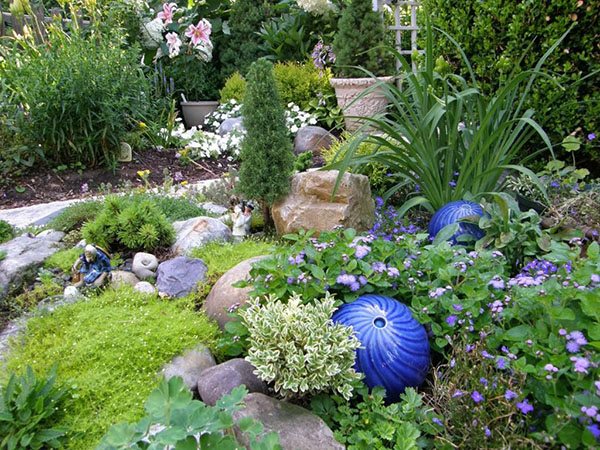

- for the rock garden, deciduous bushes with an extraordinary color, a low-growing juniper are selected, edelweiss shoots are taken as a creeping plant, next to which lavender and mountain violet are placed;


- for rockery, medium-sized conifers are selected (dwarf pine, western thuja), smaller ones are placed next to large stones, low shrubs (Kuril tea, Japanese spirea) are planted next to conifers (Kuril tea, Japanese spirea), the edges of rockeries are filled with soil plants, placing them in groups (gentian, edelweiss, creeping thyme, subulate phlox and others).


Leontopodium should not be placed next to bright, large flowers. Against their background, it fades and becomes almost invisible.
How to transplant correctly?
The root system of alpine edelweiss is characterized by sufficient length and branching as a result of adaptation to the conditions of rocky terrain. Therefore, when replanting a plant, it is necessary to make rather deep holes. The roots should fit well in the groove and should also be properly spread.Then they are sprinkled with dry earth and watered a little. With the appearance of new side shoots, one can judge the effectiveness of the transplant, as well as with the growth of the bush and flowering next year.
Growing edelweiss from seeds
The flower is propagated by seeds. The seeds of the plant are equipped with parachutes resembling dandelions and are very easily carried by the wind.
It is better to plant in the ground with seedlings. The seedling mixture should consist of garden soil, perlite and coarse sand. The seeds are scattered over the surface of the mixture without deepening. The container is covered with glass or foil. It is necessary to open seedlings only after the emergence of seedlings. It is recommended to plant seedlings in open ground in April or early May.
Seeds can be sown directly into the ground, for example on an alpine slide. But the ground should already be warm enough. Seedlings of the plant grow for a very long time, sometimes up to two months. But they can appear within a week.
It is easy to determine whether a plant has taken root by the appearance of lateral shoots.
In July-August, the plant reaches 3 centimeters and already has 2-3 leaves. At this time, they should be cleared out. The holes where the edelweiss grows must be deep. When planting in a hole, the roots are straightened and sprinkled with slightly dry earth. Further, abundant watering is required.
The flower will grow intensively and bush, next year it will bloom in late spring.
Grown plant bushes can be divided, but only with great care.
The plant must be planted away from creepers... They will suppress the growth of edelweiss with their root system. Because of this, he may even die. It is required to remove weeds on time.
Before the cold weather, it is recommended to mulch the flower with wood mulch or peat. The flower is hardy enough, but the mulch will keep the snow on top of the sleeping plant.
How to plant and care for your garden culture
The culture can be planted on the site by the seedling method, or sown directly into the ground. The disadvantage of the latter option is that flowering will not occur this year.
In the spring, with the onset of warmth, edelweiss seeds can be planted directly into the ground. For this, a place is marked out on an alpine slide or rockery, and seed material is placed there. There is no need to plant deeply, because in nature the seeds are carried by the wind, and they easily take root in crevices without being covered with soil.
The optimum planting depth is 1 cm at a distance of 7-8 cm. In the future, if necessary, planting can be thinned out, leaving a distance of 15-20 centimeters between the bushes. To preserve moisture in the soil, and better germination, the area with sown edelweiss is covered with a film.
The bushes grown at home by the seedling method are planted in open ground in May or early June. Pits are dug, watered, and plants are planted in them along with a clod of earth. Flowering will come next year.
Watering and feeding
Abundant watering of alpine edelweiss is not required. In the season with moderate rainfall, it is not needed at all. From an excess of moisture in a plant, roots can rot. In case of heavy rainfall, the planting should be covered with a film.
Alpine edelweiss does not like fertilizing, especially organic matter. It develops best in infertile, rocky ground. You can feed a little in the fall so that the plant will endure the frosty winter.
Flower transplant
When the bushes are too overgrown, they need to be planted. To do this, pits are dug, watered, the roots of the transplanted flowers are gently straightened, sprinkled with dry soil. An indicator that the plants have taken root is the appearance of lateral shoots on the stems.
Weeding
To prevent young bushes from overgrowing with weeds, the site must be weeded. Since the plants are located close to each other, it is better to do it manually. The use of glanders can damage the stems and rhizomes of the culture.
Reproduction and planting of edelweiss
Edelweiss from seeds for seedlings at home


Edelweiss seeds photo
Edelweiss is grown from seeds, more reliably obtained by seedlings.
- In February or March, prepare a mixture consisting of two parts of garden or deciduous soil, one part - perlite, coarse sand.
- Sprinkle the flower seeds on top of the soil, pressing with your palm.
- Pour from a spray bottle, without waterlogging the earth.
- Cover the nursery with foil or glass, keeping the temperature at about 10 degrees.
- When seedlings emerge, remove the cover and place the container with seedlings in a well-lit, warm place.
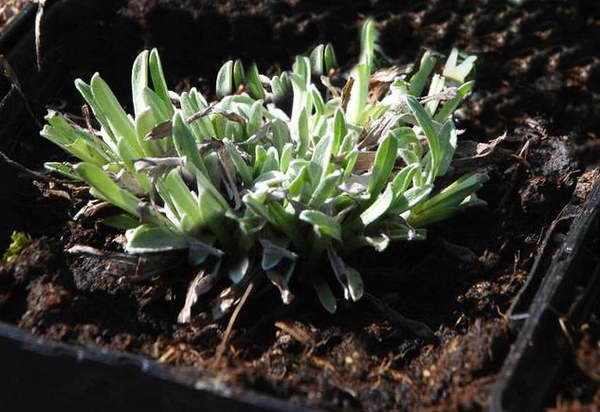

Edelweiss seedlings photo
- Seedlings will grow for a long time, upon reaching 2 cm, the seedlings are planted in separate pots for "growing".
- Water it sparingly, preventing the soil from drying out, but not flooding the plants, otherwise rot will appear.
Seedlings are planted in the ground in late April - early May, keeping a distance of about 15 cm between flowers.
Growing edelweiss from seeds in the open field


How to sow edelweiss in the open field Photo of seeds
In nature, light edelweiss seeds are carried by the wind and they, clogged in the cracks between the rocky soil, germinate easily even in the absence of soil, if there is enough moisture. Therefore, when sowing, do not deepen the seeds too much, it will be difficult for them to break through the thickness of the earth.
In order not to fool with the seedlings, in the already warmed-up soil, without the threat of frost, sow the seeds directly on the site - "alpine hill". The planting depth is 1-2 cm, the distance is as rare as possible, after that you will have to thin out the seedlings, leaving 7-8 cm between them.Grown bushes can be planted less often, leaving 15-20 cm between them.
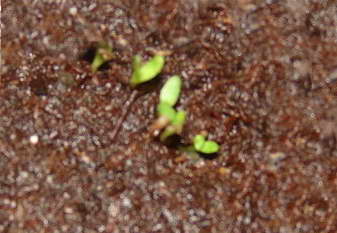

Edelweiss shoots photo
It is recommended for both sowing cases to stratify the seeds for about three weeks - mix the seeds with moist soil and put in the refrigerator in a bag for one to two weeks.
It takes about a couple of months to wait for seedlings, but under suitable conditions, seedlings may appear after a week.
Dividing the bush
Perennial bushes can be divided, acting very carefully, trying to injure the roots as little as possible. Better to use a sharp garden tool or a well-sharpened knife. The bush is carefully dug out, trying not to upholster the ground, and cut into 2-3 pieces with several points of growth. The recommended distance between the resulting plants is 20-30 cm.
How to keep flowers from aging


During the period when edelweiss blooms, which have reached a year and a half, is considered their youth. It is a pity that after another couple of flowering, they become mature and begin to age. To protect them from this and keep them in the rock garden, you need to start the reproduction procedure by the method of division.
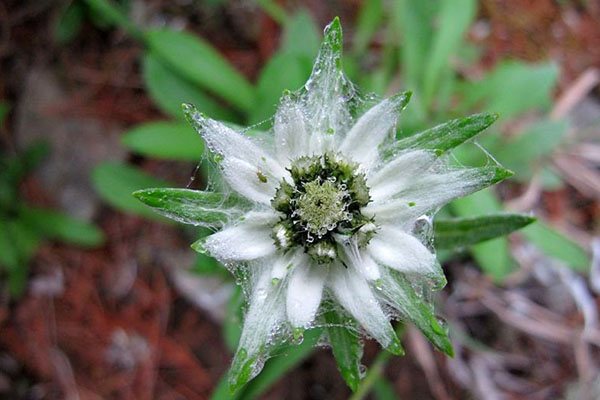

To do this, in early spring, the bush is dug up and divided into 10 or more parts. All parts can be planted by propagating the plant in this way. But after a few years, when the flower fills all the necessary places, you will have to get rid of unnecessary parts by sending them to compost or delighting friends with exotic seedlings.


Rejuvenation is the key to good growth and a beautiful appearance. Edelweiss, planting and caring for which excludes division of the bush, will begin to die in five years. After all, it does not grow over the area of the flower bed, and at the same time it practically strangles itself with roots.
Medicinal properties and harm
For medicinal purposes, alpine and Siberian edelweiss are usually used. The chemical composition of these plants determines their properties:
- anti-inflammatory;
- anticonvulsant;
- antioxidant;
- expectorant;
- anti-stress;
- tonic.
Leontopodium strengthens the immune system, which prevents colds, allows you to successfully resist toxins, slows down the natural aging of the body.
No harmful and poisonous substances were found in the plant, there are no contraindications to its use. Its preparations are not recommended for individual intolerance, and in cases of pregnancy and lactation, a doctor's consultation is required.
Reproduction methods
In nature, the plant reproduces freely by seeds, they are like a dandelion and are carried by the winds over long distances, because this is the so-called flower with parachute seeds. You can also propagate by dividing the bushes that have already taken root and grown well.
Alpine edelweiss cultivation from seeds
In household plots, it is more convenient to propagate a flower with the help of ready-made seedlings, or independently grow it from seeds in advance.
To do this, from February to March, the seeds are evenly distributed over the surface of the soil, which consists of 2 parts of deciduous soil and 1 part of sand. Until the first shoots appear, containers are kept under a greenhouse made of film or glass.
Seedling growth is slow. By the end of April, the beginning of May, the seedlings are ready for transplanting into open ground.
Edelweiss bloom should be expected in a year.
In spring and autumn, you can separate the bushes, thus multiplying the flower. This must be done carefully to avoid damage. After all, the root systems of individual plants are closely intertwined.
Views
There are more than 60 species in the genus. Some of them:
- Leontopodium alpinum Cass. typus - Alpine edelweiss
- Leontopodium brachyactis Gand.
- Leontopodium fauriei (Beauverd) Hand.-Mazz.
- Leontopodium fedtschenkoanum Beauverd - Edelweiss Fedchenko, or Edelweiss Fedchenkovsky, or Plain Edelweiss, or Steppe Edelweiss
- Leontopodium japonicum Miq. - Japanese edelweiss
- Leontopodium leontopodioides (Willd.) Beauverd - Edelweiss edelweiss
- Leontopodium palibinianum Beauverd - Edelweiss Palibina species close to alpine edelweiss. Grows in the mountainous and steppe regions of Siberia, Mongolia, Manchuria, Korea. Forms bushes much larger than alpine edelweiss, but smaller flowers. Blooms in June and September. It develops on dry, permeable, light, poor, unfertilized soil. In humus soil, its leaves develop best, but it blooms a little. Florists propagate it by dividing the rhizomes in spring or late summer and by seeds. In rock gardens they are used in the same way as alpine edelweiss.
- Leontopodium nivale (Ten.) (Ten.) Huet ex Hand.-Mazz. Beih. Bot. Centralbl. xliv. II. 137 (1927) cum descr. lat. Leontopodium nivale subsp. alpinum (Cass.) Greuter Willdenowia 33 (2): 244 (22 Dec. 2003)
Postage stamp of Kyrgyzstan, "Tien Shan edelweiss". However, another plant, Richteria leontopodium C. Winkl., Can be called the Tien Shan edelweiss. Probably the stamp depicts Leontopodium leontopodioides - Edelweiss edelweiss.
Sports glory
Few people know that the edelweiss flower is actually a symbol of the harsh mountaineering sport. The Mountaineering Union established an order of the same name, which only a hundred of the planet's climbers have the right to wear. This honor was given to the plant due to the specificity of its habitat: in order to get a flower in its natural environment, it is necessary to conquer high rocks.


How to properly trim zamioculcas
The question of how to properly cut a zamioculcas can be heard quite often. With normal development, the plant does not need pruning, it forms its own crown. Zamioculcas are pruned when they want to rejuvenate the old leaves that have become woody in the lower part, or simply give the plant some specific shape. If, due to improper growth, it is necessary to cut off the zamiokulkas for better nutrition of the branches, it is best to do this during the period of active growth - in the spring.
Growing conditions
This plant is completely unpretentious. Edelweiss is a mountain flower, therefore it does not need nutrient soils. On an alpine hill among the stones for him the most familiar and suitable conditions. The soil must pass moisture well, since stagnation of water for this plant is destructive, therefore, it is necessary to provide good drainage in the form of small pebbles or river sand.
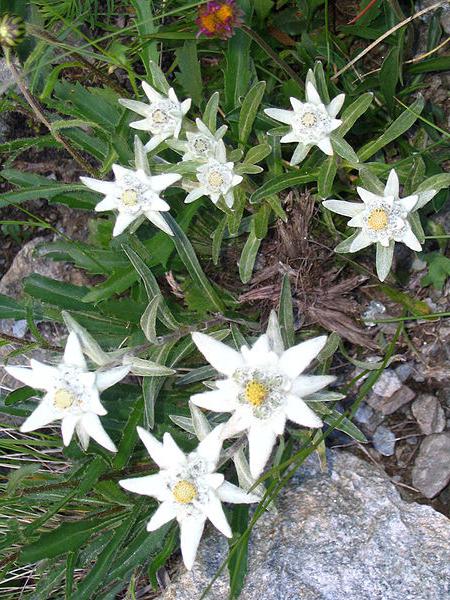

The plant is shade-loving, so you should not choose a sunny area for planting, but not too shaded. Although edelweiss is a very hardy flower and is not afraid of frost, winds or sunlight, it will develop very slowly under adverse conditions.
Landscape design
Edelweiss is widely used in the creation of mixborders, for decoration of the foreground and rocky areas.Designers consider the Alpine aster, miniature roses, violet and aquilegia to be the best neighborhood for the plant. Therefore, they are often planted when decorating a rockery, an alpine slide, a flower garden.
We remind novice gardeners that graceful garden plants by their neighborhood make the modest edelweiss invisible. It visually disappears next to the luxurious flowers. And it looks most advantageous alone.
If you collect beautiful half-opened edelweiss flowers and place them in a vase of water, they retain their beauty and freshness for a long time. Dried flowers do not lose their silvery color and shape at all, ideal for creating winter bouquets.
| Edelweiss in Wiktionary |
| Edelweiss on Wikisource |
| Edelweiss at Wikimedia Commons |
Legends
So what legends surround the edelweiss flower, what secrets does it keep?
- White is the color of spiritual purity, therefore edelweiss has long been associated with the soul. One of the legends says that the lovers threw themselves off the cliff, not resigning themselves to the need to part. At the place of their death, as a symbol of grief, edelweiss flowers grew.
- Another story tells of the "stars of the mountain witches" who raise and cherish them. The thing is that edelweiss flowers retain their freshness and aroma for a long time, even if they are plucked. Hence it went that these are the tricks of magicians or witches protecting their natural treasures.
- One of the most romantic and dramatic legends was invented by the peoples of Western Ukraine: two twin brothers, fighting for the heart of a beautiful lady, decided to find out whose love is stronger. Whoever brings the girl an unusually beautiful mountain flower wins. Clambering over the rocks, one of the brothers fell off. A relative tried to catch him, but this only ruined both of them. The frustrated girl jumped into the abyss in grief.


Edelweiss is a mountain plant, therefore legends are often associated with the inaccessibility of its collection.
Thus, edelweiss combines the bitter dramas of unhappy love, issues of life and death, magic and mysticism, magic. For each edelweiss has prepared something of its own, so homely and close to the heart that it is impossible not to feel the legend "on your own skin."
Meaning and application
Edelweiss has long and still been one of the favorite plants for gardeners for rock gardens.
Botanists Jean-Paul Vigneron and Virginie Luss, photographing an edelweiss flower in different rays of the spectrum, found that the plant completely absorbs ultraviolet light. By examining the perianths under an electron microscope, scientists have learned that edelweiss are covered in tiny white hairs composed of parallel cellulose fibers 0.18 micrometers thick, close to half the ultraviolet wavelength that reaches Earth. This layer of hairs absorbs radiation that can burn leaves in the mountains. At the same time, such a “filter” of hairs allows visible light to pass through, which is necessary for photosynthesis. A sunscreen made from such nanoparticles, if developed on the basis of this discovery, could provide complete protection for human skin from sunburn. [5]
Features of the terrain
Knowing the origin of a flower, you can determine its preferences in climatic conditions: humidity, shade, etc. But with edelweiss, not everything is so simple: different types of flower were simultaneously found in several regions, which makes it necessary to determine the type of plant before planting it.
- Alpine edelweiss grows on the rocks of Europe, Central and Asia Minor, in the Alps. Due to strong winds, the flowers form small shrubs 25 cm tall, heavily pubescent, due to which they have a pleasant silvery shade.
- The dwarf edelweiss was found in the Himalayas, China, preferring an altitude of about 4000 meters. Unlike its alpine counterpart, this type of flower is a stunted perennial with spatulate leaves of a dark green color.Dwarfs are extremely picky about the soil: it should have a low humus content, during the growth period it must be moist.
- The edelweiss of the Kuril Islands does not even reach 16 cm in height. The plant is cobweb-felt, which makes it difficult to grow in an apartment. Nevertheless, in the country, such a plant looks original on stones and stumps.
- One of the most beautiful species, along with the Alpine, is the Siberian edelweiss, or Pilibina. It grows in Korea, Mongolia and Siberia, differs in a smaller diameter of buds than that of an alpine relative. It grows in bushes, which allows planting in the country without any problems. However, it is necessary to monitor the soil moisture and wind in the area. The plant should not overheat.


Edelweiss of the Kuril Islands does not grow very large


Alpine edelweiss has a rather long stem and a silvery shade
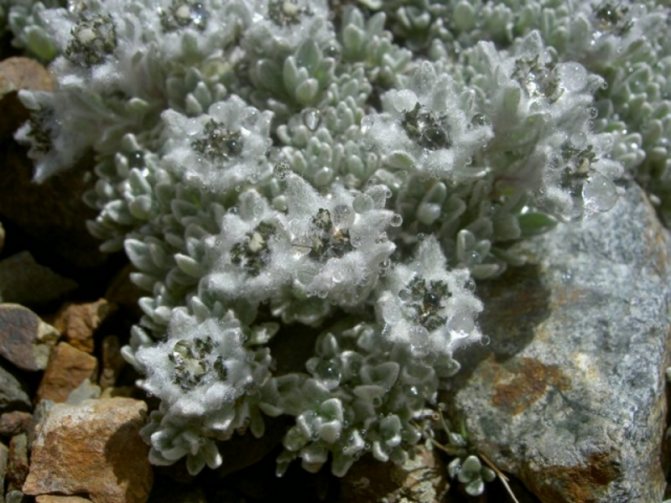

Dwarf edelweiss grows no more than 10 cm and spreads along the ground
Beneficial features
Herbal ingredients from the silver star are widely used for the preparation of cosmetics. The extract from plant shoots is credited with a wide range of useful qualities:
- regenerating;
- antioxidant;
- antifungal;
- antiseptic;
- slowing down the aging of the skin.
The peculiar beauty and the possibility of using edelweiss flowers made it a profitable business. Entrepreneurs who successfully grow and propagate an exotic plant do it on a large scale, planting huge plantations with flowers.
Name
Edelweiss has the Latin name Leontopodium, which means lion's paw. The flower received such a telling name for its characteristic appearance - the edelweiss inflorescence in its structure has several round pubescent pads resembling a lion's paw. The edelweiss petals are also covered with thick silvery hairs, which makes the flower look like a skillful piece of felt.


Leontopodium
Features of Edelweiss
The history of the plant is very beautiful. It is about courage and love, and the flower itself, according to one of the legends, appeared on the slopes of the mountains from the tears with which the girl cried, yearning for her beloved. It is believed that if a man finds Edelweiss in the mountains and gives it to a woman, then he truly loves her.
Where does Edelweiss grow in the wild?
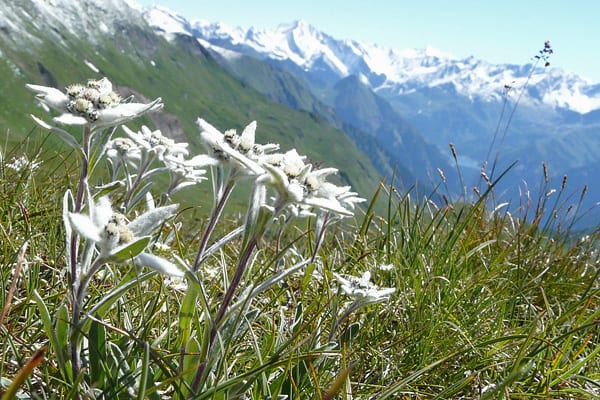

- In the wild, flowers grow among rocks in the mountains at a level of 1,800-2,000 km above sea level. The area of growth is the subalpine and alpine belt, more often you can find in the Carpathians and the Alps, as well as in Tibet and in the Himalayas.
- There is also such a variety as Edelweiss Palibina, which can be found in Siberia, Mongolia and Korea. There, it is also distributed only in mountainous areas. This plant is slightly larger than Alpine Edelweiss.
- The flowering period begins in early summer and lasts until August. Small white flowers look great in rocky areas, where there is little vegetation, and especially flowering specimens.
Botanical description
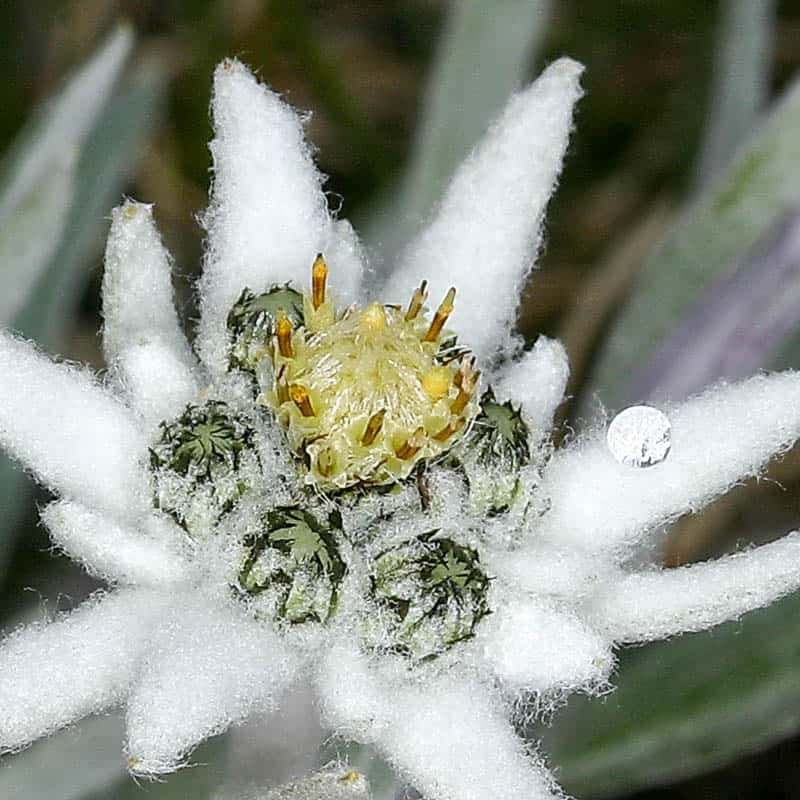

- Edelweiss can be an annual or perennial, dicotyledonous, belongs to the Asteraceae (Compositae) family. The plant is distinguished by its endurance and reaches a height of 25 - 30 cm, and a width of 15 - 22 cm.
- Since it is located high in the mountains, where the humidity level is high, the leaves and stems are covered with a grayish tomentose pubescence, which protects the flower from excessive moisture evaporation.
- The flowers are mostly pure white. The inflorescences are collected in baskets, differing in density. They are connected into heads. The structure of the inflorescence is quite strong and firm, as there are high winds in the rocky area.
- The leaves, which gather at the very top of the flower, form an asterisk. Because of this, the French call Edelweiss "the Alpine star".
- Another name Leontopodium, translated from Greek means "lion" and "leg", is a more scientific definition. It happened because the shape of the flower is like a lion's paw.The very name "Edelweiss" is translated as "noble" and "white" (transliteration from German).
- The stems on which the flowers bloom emerge from a rosette of leaves lying on the ground. The rosette is lanceolate. The leaves in the upper part are dark green in color, and in the lower part they are almost white and still pubescent.
- It is the presence of villi that allows Edelweiss to endure severe winters, being in mountain gorges, even with a small amount of snow. The plant is not afraid of the sun, on the contrary, it attracts its leaves and flowers to it.
- If the conditions are favorable, then at the end of flowering a cylindrical achene is formed, where a large number of fluffy seeds - "parachutes" are located.
Often these hardy and strong flowers are called "molds" because of the fluffy coverage of stems and leaves. In total, today there are about 40 types of Edelweiss. However, if you want to grow a flower in a hot climate or in a place where there is too much humidity, then this is unlikely to work, since under such conditions Edelweiss does not grow.
Edelweiss flower legend
This handsome man is included in the list of plants in the Red Book of Russia. The plant is threatened with complete extinction, because at the moment its number in nature has significantly decreased.
edelweiss flower photo in the wild
The Swiss consider it a symbol of the country. But, unfortunately, now in Switzerland the flower is extremely rare. The government even passed a law prohibiting the collection of edelweiss in order to protect it from tourists and preserve it in the natural environment.
Where does it grow? It grows in the rocks of Tibet, the Himalayas, the Carpathians and the Far East. What does an edelweiss flower look like? It looks like a small silver star or pearl. It is a herbaceous perennial plant 15-30 cm in height, and grows about 20 cm wide. The outer area of the leaf plates is colored bright green, and the lower one is covered with small white villi that protect the foliage from frost.
Another name - Leontopodium (lion's foot) - the plant received for its flowers, which outlines look like lion's paws. The inflorescences are complex, the bracts are in the form of rays of white color, they are up to 10 cm in diameter. In the center are yellowish inflorescences, soft and slightly fluffy to the touch. Flowering begins in late summer and lasts a month until autumn. In place of flowers, cylindrical boxes with small seeds ripen.
Translated from German, the name means "noble white". The French call it the alpine star. In Switzerland he is known as the "Queen of the Alps". And all over the world, this plant symbolizes love, devotion and courage.
Edelweiss: the legend of the flower
If you look objectively, then this modest flower does not surprise at all with its beauty, against the background of other plants. But it amazes with its mystery. Long ago, men even risked their lives to bring mountain edelweiss for their beloved, it was a symbol of courage and courage. This flower is surrounded by many legends and myths.
One legend tells of an unusually strong feeling of two lovers who were waiting for eternal separation. But they chose to jump off the cliff together. And then, in that place, edelweiss grew on the stones, as a sign of triumph and sadness.
There is a more fantastic legend, it tells about mythical beauties with long nails who live on high steep rocks. They are engaged in the cultivation of edelweiss, care for them and protect them from people. The daredevils who steal their flowers are thrown into the abyss by the beauties. Only people with real and sincere feelings are allowed to take the asterisk with them.
Having got acquainted with the legends about the "silver star", you understand why many people want to conquer this mountain flower and grow it on their farm.
Growing indoor zamiokulkas: how to plant a plant in a new pot
Zamioculcas zamielistny (Z. zamiifolia);
Zamioculcas lanceolate (Z. lanceolata);
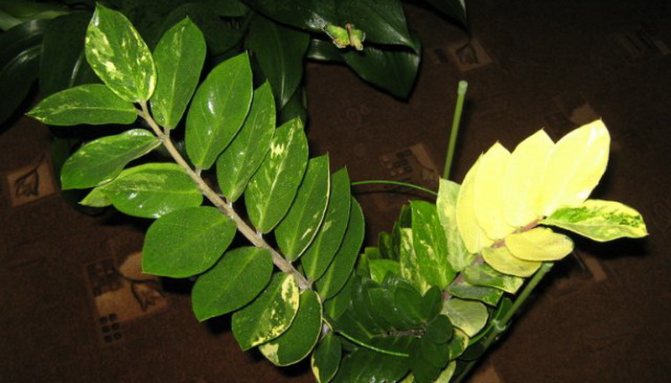

Zamioculcas variegated (Z. variegated).
It is interesting for novice plant breeders to know how zamiokulkas blooms in nature and at home? The flowering of zamiokulkas in nature is a rare phenomenon, since it happens only at a very mature age. In room culture, under appropriate conditions of maintenance, good care, the plant blooms with white and light cream flowers, but already at a fairly old age.
The inflorescence is an ear. Flowers of different sexes are located separately on the cob, female - from below, male - from above, and between them there is a zone of sterile flowers. Due to this structure of the inflorescence, its self-pollination is impossible. In nature, the succulent is pollinated by the wind or by crawling insects that live in the plant's homeland.
The photo shows how the zamioculcas blooms: inflorescences consisting of an ear and a veil, which appear at the very base of the leaves at a very old age of the plant.
Before planting zamiokulkas, you need to properly prepare the composition of the soil. The soil for zamiokulkas should be loose and porous. Sand or perlite is added to it by at least a quarter of the volume. Good drainage is essential. At the bottom of the pot, drainage is made from expanded clay, also by a quarter. For better development of a plant in a new pot, its tuber must not be completely lowered into the ground.
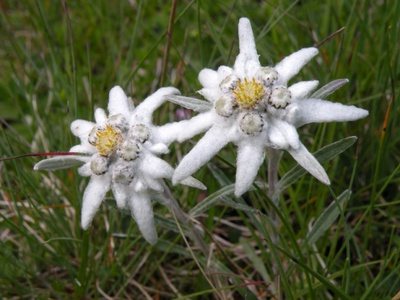

Due to the small root system, the flower grows slowly, therefore, young plants should be transplanted no more than once a year, slightly increasing the volume of the pot, and adults - no more than once every 3-5 years. It is better to plant zamiokulkas in the spring. It is necessary to work with rubber gloves, as the plant sap is poisonous. At home, transplanting zamiokulkas in the spring allows the tubers to better acclimate and quickly build up green mass.
At home, reproduction of zamiokulkas is possible in several ways. This plant reproduces vegetatively.
Reproduction of zamiokulkas by leaf cuttings is the most preferred method. A well-developed, complex, middle-aged leaf on an adult plant is used for harvesting cuttings. In the lower part of the leaf, leaf blades are removed from the rachis. For planting, you can take only a part of a large leaf - the top is 15-20 cm long with 4-5 leaves.
It is better to dry the stalk a little before planting. When rooting cuttings, it is advisable to use soil heating, as well as to use phytohormones for better root formation. Leaf blades and cuttings are rooted in a mixture of sand and peat (1: 1) in a warm place with diffused lighting, covered with glass or polyethylene to maintain moisture.
Under these conditions, the leaves form a rounded tuberous organ on which the bud and roots develop. The pot with the shank is placed in a warm place and sprayed regularly. Rooting can take up to two months. When the roots appear, the stalk of the zamiokulkas is transplanted into a small pot with a loose substrate (for example, soil for cacti and succulents). When planting in ordinary soil, sand, perlite, vermiculite are added for porosity.
In addition to the above-described method, it is possible to multiply zamiokulkas in water used as a medium for the formation of the root system. A strong, mature stalk is selected and separated from the mother plant. Then the cut site is treated with root-forming stimulants (root, zircon, heteroauxin).
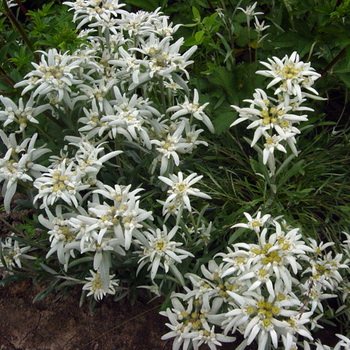

Reproduction of zamiokulkas leaf at home is as follows. In an adult plant, the leaf is separated from the central vein (rachis) of a complex leaf, the cut is sprinkled with charcoal, the cut leaf is dried for 1-2 hours and planted at an angle in a glass with soil so that 1/3 of the leaf is in the substrate.
Reproduction of zamiokulkas by a tuber is a fairly simple way that only an adult plant with large tubers can be propagated.The tuber, growing, divides itself, and the daughter tubers are formed quickly enough. At the next transplantation of the mother plant, the tuber is divided so that at least one growth point is preserved in each part.
The larger the part taken for reproduction, the faster a developed plant will turn out. After dividing, the resulting parts are dried for several hours, the sections are treated with charcoal and planted in containers filled with a light substrate with a loose structure, not much burying the tuber head. Regular moderate soil moisture begins 3 days after planting. Dividing a tuber is not the most convenient way of propagation, since a new bush grows very slowly.
Growing seedlings
Sometimes representatives of this species can grow up to thirty centimeters high. Due to the root system, which has creeping properties, the plant clump can grow at a distance of 25 cm. Due to this advantage, the plant is often used as a ground cover in a personal plot.
For the growth of alpine edelweiss, it is important to have a cool climate and sufficiently drained rocky soil or sandy soil, if we take into account its natural habitat. Negatively refers to hot weather conditions combined with high humidity. The flowering process begins at the end of summer and continues until the beginning of the autumn period.


The most famous type of edelweiss is Alpine
Alpine edelweiss is great for creating rockeries and rock gardens, and dried flowers can be used as a component of a winter bouquet.
Another interesting species is the Palibina edelweiss. This species is very similar to the Alpine representative, however, the size of the formed bush is much larger, but the flower is inferior in its parameters to the inflorescence of the alpine relative. This species is an inhabitant of mountainous regions and steppe regions of Eurasia, and also grows on the territory of the Korean Peninsula.


Edelweiss Palibina
The reproduction process is carried out by sowing seeds or dividing the root system. The best time for this is spring or autumn.
To plant in open ground, it is enough to simply plant seeds on its surface, observing a distance between units equal to 8-10 cm.
Plants can also be grown at home. In this case, it is important to observe the correct temperature regime, not exceeding 10 degrees. Before planting, the seeds must go through a stratification process, the essence of which is to mix the seeds with a part of the moistened soil, after which this mixture should be placed in a cool place (refrigerator) for 21 days.
After a three-year period, edelweiss need to be transplanted to another place for further growth.
Under natural conditions, edelweiss are considered winter-hardy, but if we are talking about garden cultivation, then when winter comes, there is a need to mulch the plant, which will imitate the snow cover. When the spring heat arrives, the mulch can be removed. It is important to remember that precipitation in the form of heavy rains can have a negative impact, so flowers need to be protected from heavy torrents. If the flowering period of some specimens is over, they should be disposed of to preserve the aesthetic appearance of the entire plant.
Edelweiss is propagated, most often from seeds, preferably by seedling, sowing it in February-March in a soil mixture of deciduous soil and sand (2: 1). The seeds are not deepened, but scattered over the soil surface. The box is covered with glass or foil, which is removed when shoots appear. Plants grow slowly.
In late April and early May, seedlings can be planted in open soil. Edelweiss can be propagated by dividing the bush in spring or autumn. True, edelweiss bushes are very closely intertwined with roots, therefore, when dividing them, you should disassemble them very carefully.They will bloom next year. Plants can grow in one place for 2-3 years. So that they do not lose their decorative effect, they should be transplanted to another site.

